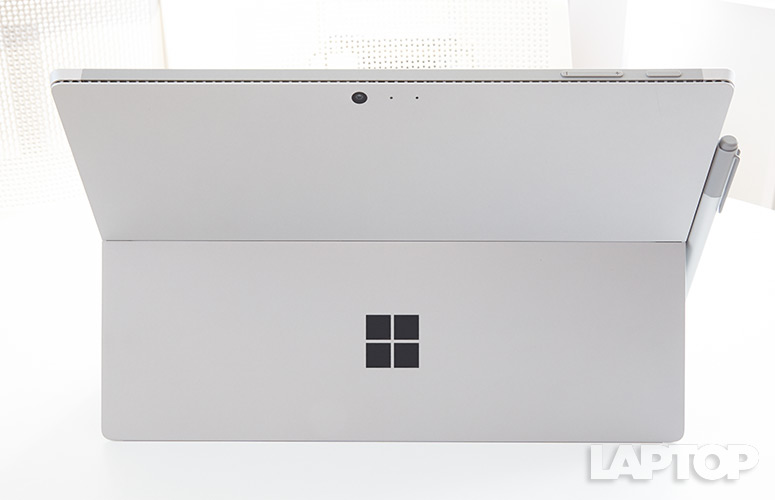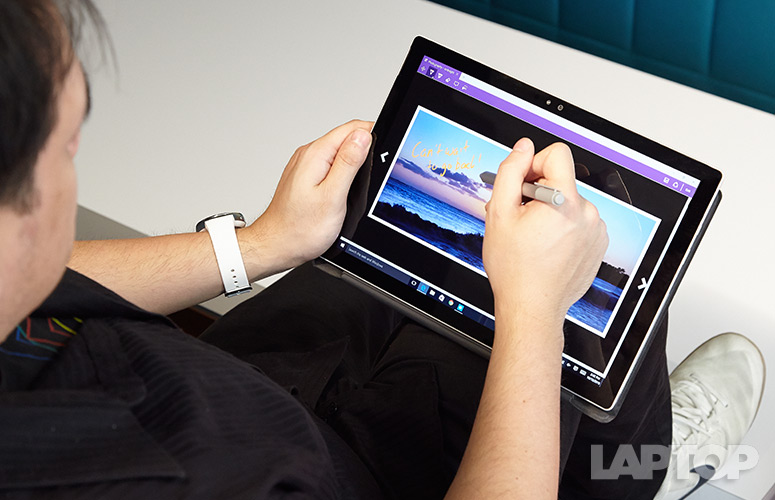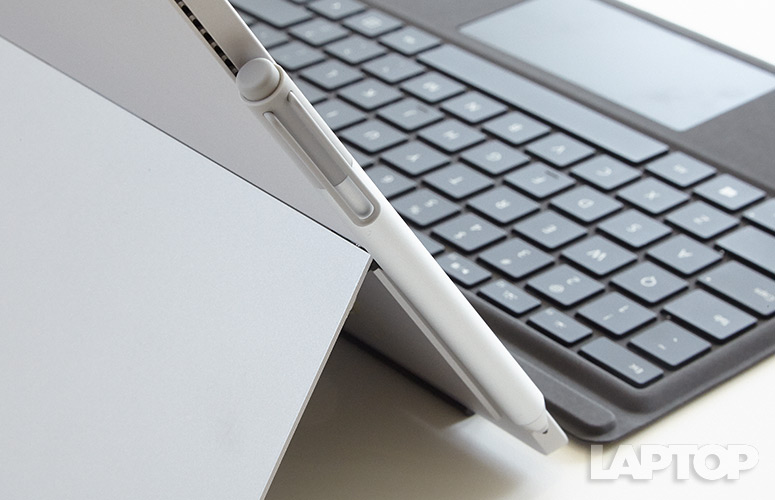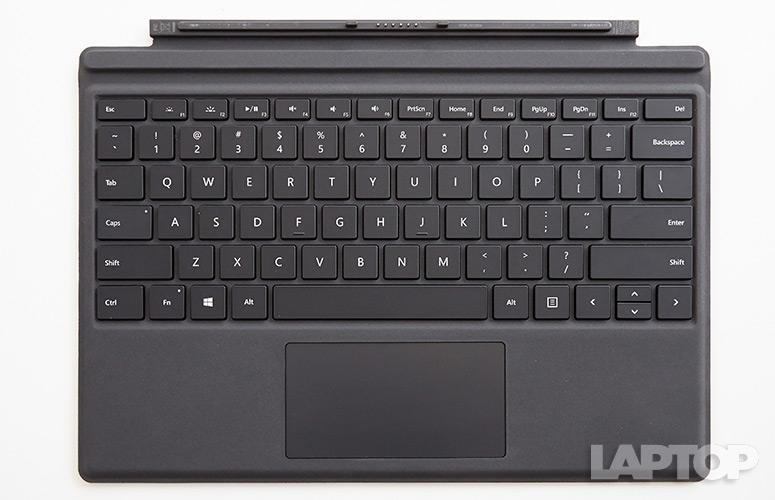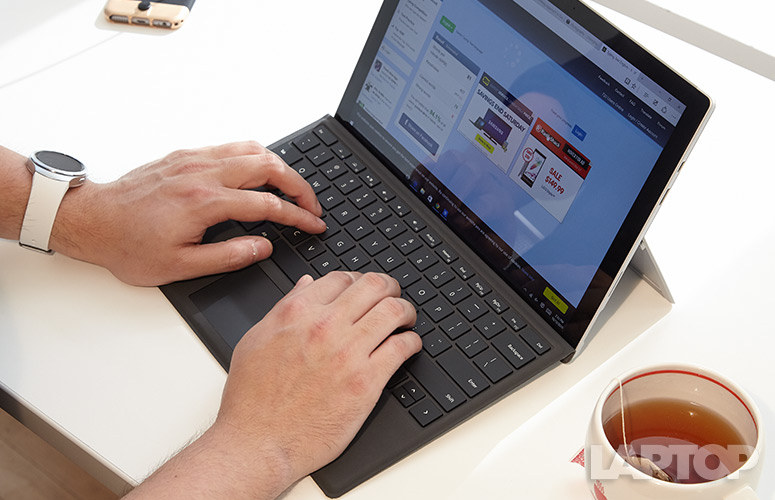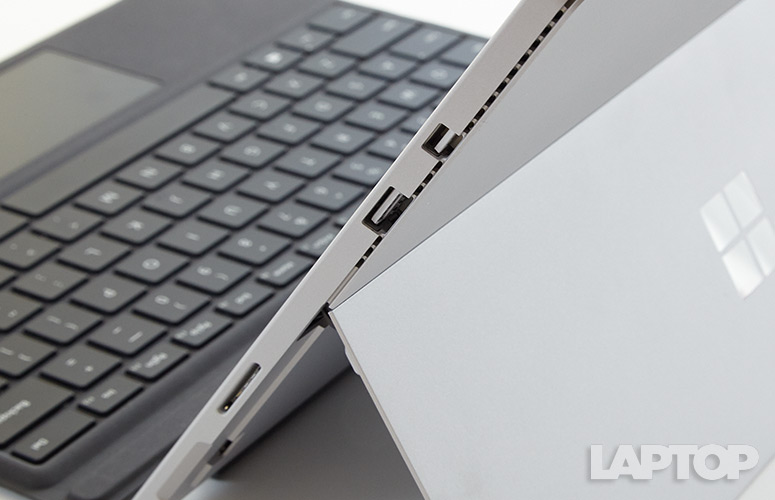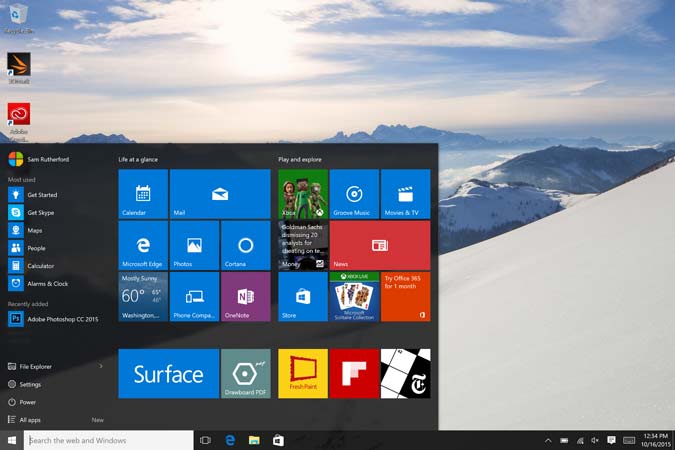Laptop Mag Verdict
While it might not look new on the outside, the Surface Pro 4 features a faster CPU, bright high-res screen and improved Type Cover but with much less battery life.
Pros
- +
Best Type Cover yet
- +
Bright Pixel Sense display
- +
More sensitive stylus with eraser
- +
Speedy SSD and 6th-gen Intel CPU
Cons
- -
Below-average battery life
- -
Pricey (especially for Core i7 models)
- -
Glitchy rear camera
Why you can trust Laptop Mag
While there are still a lot of traditional notebooks that Microsoft's tablet/laptop hybrid hasn't yet killed, the Surface Pro 3 changed the landscape of mobile computing. Now, the likes of HP, Lenovo, Dell and even Apple are chasing Microsoft's coattails with their own all-purpose devices. But before those machines can hit the shelves, here comes the Surface Pro 4.
Editors' Note: We initially rated the Surface Pro 4 3 stars partly because we tested a number of review units equipped with defective cameras. However, in the three months since its release, we continued to test updated models and retail versions and have not encountered the same issue. As such, we feel confident in raising the score to 3.5 stars.
The SP4 (starting at $899, and $1,429 as reviewed) plays it safe with an exterior design that's almost exactly the same as the old one. The big changes come in the stunning 12.3-inch PixelSense display, more sensitive stylus, new 6th-gen Intel processors, and wider range of memory and storage options. This makes the SP4 faster and more useful than any Surface ever before. But with the new competition, including the even-sexier Surface Book, is the Surface Pro 4 still the best hybrid device on the market?
Design: Some things stay the same
Unless you pull out your magnifying glass, the Surface Pro 4 looks nearly identical to last year's model, although that's not really a bad thing. The magnesium body feels solid, as does the friction-hinged kickstand, which rotates back with a stiff but secure-feeling action. There's a thin vent that runs part of the way around the edge to help cool the system and a new, shiny Microsoft badge on the back. The angled edges are sharp without being painful, and, as before, the Type Cover flips around and lies flat against the back when you put the device in tablet mode.
The SP4 is a bit larger than the SP3, at 11.50 x 7.93-inches versus 11.45 x 7.8 for last year's model. But it makes up for that increased size with reduced weight and thickness, at 1.73-pounds and just 0.33-inches thick (1.76 pounds and 0.36-inches for the SP3). When you add on the Type Cover, the full dimensions are 11.50 x 7.93 x 0.43-inches and 2.37 pounds.
Compared to more-traditional notebooks and 2-in-1s, the SP4 is smaller. HP's 13-inch Spectre x360 13t and Toshiba's Satellite Radius 12 are both bigger and heavier, at 12.79 x 8.6 x 0.6 and 3.26 pounds and 11.8 x 8.2 x 0.61 and 2.9 pounds, respectively. Even the svelte Macbook Air seems portly, at 12.8 x 8.9 x 0.11-0.68 inches and 2.96 pounds.
Sign up to receive The Snapshot, a free special dispatch from Laptop Mag, in your inbox.
Stylus: More sensitivity and a better feel
The new eraser on the Surface Pro 4's stylus is a simple improvement with a big impact. You can still push it down to open OneNote, but when you actually get to writing, the eraser makes it easier and more natural to fix a stray stroke or errant effort.
The sensitivity has also been upped to 1024 levels of pressure (versus 256 for the old model), a big improvement for the artistically inclined. And with the new $10 Pen tip kit, you can switch out the nib to suit your needs. I particularly enjoyed the HB tip, which feels a lot like a traditional pencil, right down to the smooth-but-not-quite-slippery resistance.
Type Cover: A little spacing makes a big difference
Previously, when I recommended either the Surface 3 or Surface Pro 3, I had to mention that people should try the keyboard before buying to make sure they would like it. But with the Surface Pro 4, that caveat is a thing of the past.
What many people may not have realized is that previous versions of Microsoft's Type Cover (both for Surface 3 and Surface 3 Pro) had oversized 14 x 14mm keys that were bigger than what you'd get on a typical laptop or desktop keyboard. The problem was that the old layout had almost no space among the keys, which made it easy to hit multiple keys at the same time resulting in unnecessary typos. So for the Surface Pro 4, Microsoft has reduced the keys to a standard 12 x 12mm size and switched over to a more well-spaced, chiclet-style layout, which is much more comfortable for typing.
When you add in longer key travel (1.4mm for the SP4 versus 1mm for SP3), a heavier actuation weight (59 grams for SP4, 50 grams for SP3) and the same bright backlighting, I can say with confidence that this is the best Surface keyboard Microsoft has ever made.
However, the Surface Pro 4 is still a little awkward to use in your lap due to its unusual balance and thin rear kickstand.
The reduced key size makes for more real estate below the keyboard, which let Microsoft expand the touchpad to 4 x 2-inches on the Surface Pro 4, up from 3.5 x 1.7-inches on the Surface Pro 3. That means there's now even more room to luxuriate in the soft-touch surface when mousing around and using gestures. Even clicking feels a little bit snappier.
Display: The Surface Pro has never looked better
The new PixelSense display on the Surface Pro 4 is stunning. The 2736 x 1824, 12.3-inch screen is bright, colorful and simply a joy to look at. When I watched the trailer for MTV's The Shannara Chronicles, everything from the turquoise Elfstones to the blood-soaked orcs looked sharp and vivid.
With an average screen brightness of 382 nits, the Surface Pro 4 is brighter than any Surface yet, and more luminous than its competition. The Spectre x360 (339 nits), Satellite Radius 12 (338 nits) and the 13-inch Macbook (334 nits) were close, but still noticeably dimmer.
The Surface Pro 4's color accuracy is nearly perfect, achieving a Delta-E rating of 0.35 (numbers closer to zero are better). The Toshiba Satellite Radius 12 and HP Spectre x360 were less accurate, but close, with Delta-E ratings of 0.6 and 1.25. The Macbook was a good deal worse, with a rating of 4.3.
Editing photos is a pleasure with a color range that almost perfectly covers the sRGB spectrum (99.7 percent). HP's x360 has a slightly wider color range, at 103.2 percent, while Toshiba's Radius 12 was almost identical, at 100 percent. The 13-inch Macbook Air was much more limited, at 65.8 percent.
Audio
Traditional laptops could learn a thing or two from the Surface Pro 4, whose dual, front-facing speakers positioned on either side of the screen project audio toward your ears, instead of to the sides or into a desk like some other systems do. The speakers aren't superloud, but they can fill a medium-sized room pretty well, and there's almost no distortion. Like many portable systems, the SP4's speakers are a little weak on bass, but otherwise, audio is pretty balanced. When I listened to Major Lazer's "Lean On," I found the mids and highs to be quite crisp, although I missed the depth and impact I was used to hearing in the bass line.
MORE: Best 2-in-1s (Laptop/Tablet Hybrids)
Heat: Still hot, but it's not a deal breaker
The Surface Pro 3 had problems staying under our 95-degree-Fahrenheit comfort threshold, and so does the SP4. On the Laptop Mag Heat Test, which involves streaming 15 minutes of HD video, the bottom edge of the Surface Pro 4 reached 101 degrees. In back, the left side of the tablet measured 100 degrees, while the right was slightly cooler, at 96 degrees. Overall, temps aren't high enough to be painful, but may cause some sweaty palms if you're using the device as a tablet.
Ports and Webcam: Same ports, but say 'Hello' to new cameras
Because Microsoft didn't want to make existing Surface Pro 3 accessories obsolete, ports haven't changed on the Surface Pro 4. You get a proprietary magnetic-charging port, one USB 3.0 port and a mini DisplayPort on the right; a combo headphone/mic jack on the left; and a microSD card reader hiding behind the kickstand in back. I would have liked to see an additional USB-C port somewhere on the system, though.
The front camera features the same 5-megapixel resolution as on the SP3, but now has Windows Hello facial recognition and the rear camera has been upgraded to 8 MP. Both cameras are capped at full-HD for recording videos.
Unlike a lot of low-rent front cams, the SP4's 5-MP front shooter takes a pretty decent photograph. In a picture snapped in our well-lit office, details in my hair and shirt were sharp and in focus. However, the camera struggled a bit with exposure, as the wall behind was blown out while the overall picture looked a little dark.
Microsoft has some work to do on the software for its rear camera. On two out of the three test units we received, there was noticeable pixilation and artifacts in the upper right corner of the camera window. Plus, the camera had trouble focusing on anything. On the third unit, the pixilation wasn't as obvious, but would crop up when moving the tablet around rapidly. The camera was also very slow to focus and adjust its exposure.
Performance: Speedy SSD and improved performance
Featuring a 2.4-GHz Intel Core i5-6300U CPU, 8GB of RAM and a 256GB SSD, the Surface Pro 4 has enough oomph to deal with pretty much any non-3D-intensive application. You want to stream multiple 1080p videos with upward of 20 Chrome tabs open in the background? No problem, and there's plenty of speed left over to handle Skype, Photoshop and a few PDFs at the same time, too.
In Geekbench 3, which evaluates overall system performance, the SP4 scored an impressive 6,811. That's better than systems with older Core i5 CPUs, such as the 13-inch Macbook Air (5,783) and HP Spectre x360 (4,037), and even new Core-i7 PCs such as Toshiba's Satellite Radius 12 (5,779).
The 256GB SSD is also blazing fast, with a transfer speed of 318.1 MBps. That's two times faster than the Satellite Radius 12 (141.4 MBps) and the Spectre X360 (141.4 MBps), although just a bit slower than the Macbook Air (358.4 MBps).
Using OpenOffice, the Surface Pro 4 matched 20,000 names and addresses in just 4 minutes and 11 seconds. While that's a few seconds slower than the Macbook Air (4:03), it was a minute faster than the HP Spectre x360 (5:04) and a minute and a half faster than the Satellite Radius 12 (5:34).
Graphics: A new generation of integrated graphics
The Intel HD graphics 520 in the SP4's 6th Gen Core i5 chip is a significant upgrade from previous integrated solutions. That doesn't mean every game is going to do well at its native resolution of 2736 x 1824, but when I played Legends of Legends, the system stayed firmly above 60 fps at high graphics even without lowering the resolution.
In 3DMark's Fire Strike graphics test, the Surface Pro 4 scored 843, which was about the same as Toshiba's Satellite Radius 12 and better than the HP Spectre x360 (710).
Then, when we ran World of Warcraft at 1920 x 1080 at auto settings, the SP4 managed a definitely playable 47 fps. The Spectre x360 and the Radius 12 managed 26 fps and 13 fps respectively, at the same settings. The Macbook air managed a respectable 33 fps at the same settings, but at a lower resolution of 1400 x 900.
Battery Life: A step back
So far, everything has been looking really peachy for the Surface Pro 4, but here's the downer: subpar battery life. On Laptop Mag's Battery Test (continuous Web surfing over Wi-Fi at 150 nits), the SP4 fizzled out after just 6 hours and 5 minutes.
MORE: 10 Tablets with the Longest Battery Life
That's better than the paltry 5:17 turned in by the Toshiba Radius 12, but an hour and a half less than last year's SP3 (7:42) and 2 hours less than the ultraportable average. HP's Spectre x360 was even better (9:28), and Macbook Air 13 more than doubled the Surface Pro 4, at 14 hours flat.
Surface Pro 4 vs. Surface Book
With the introduction of the Surface Book, Microsoft now has an even more powerful member of the Surface family to choose from. The superpremium Surface Book is for people with money to burn, or who refuse to compromise on a real keyboard or optional discrete graphics. Meanwhile, the Surface Pro 4 is for people who want something that's light, portable and powerful but don't have a real need to edit videos or render 3D objects on a regular basis.
MORE: Best Laptops for College Students
It's weird saying that the Surface Pro 4 is now the midrange member of Microsoft's Surface family, but with a starting price of $1,029 (with keyboard), versus $629 for the Surface 3 (with keyboard) and $1,499 for the Surface Book, that's just how it is. The one remaining question is if Microsoft will continue to produce the SP3. If so, it's a worthy, and less expensive alternative for people who might not need the extra levels of sensitivity on the stylus, but will appreciate better battery life and still-proficient performance.
Software and Warranty: Windows 10, clean and simple
The Surface Pro 4 comes with a pristine copy of Windows 10 Pro and a limited one-year warranty. There's no bloat from preloaded trial software or annoying antivirus programs, and that's exactly how I like it. With Windows 10, you also get a ton of useful features such as the ability to make notes and drawings directly on Web pages in Edge, then save them or send them to others.
There's also Cortana, Microsoft's digital assistant. It can do a wide variety of things from creating simple reminders or finding out the score of last night's baseball game to recommending you a restaurant or movie based on your personal preferences.
Configurations: 1TB costs how much?
Please Microsoft, offer a bundle that comes with a keyboard, because without it, the Surface isn't going to replace anyone's laptop, and the not-so-optional accessory adds an extra $130 to the actual price. Models start at $899 (without a Type Cover) for an Intel Core M3 CPU with 4GB of RAM and a 128GB SSD, and can cost up to an outlandish $2,699 for an Intel Core i7 processor, 16GB of RAM and a 1TB SSD. The 512GB SSD option requires at least an i5 CPU, while the 1TB edition is only available along with an i7 chip and 16GB of RAM. But really, unless you like to have a lot of processing you'll never use, our i5, 8GB of RAM and 256GB SSD review unit hits the sweet spot in terms of price and performance, at $1,429 with a Type Cover.
Bottom Line
I want to give the Surface Pro 4 a higher score. The PixelSense display is superb bit of engineering, and the new 6th Gen Intel chip delivers the kind of swift performance I'm looking for, but the 6-hour battery life holds the SP4 back from glory. For stylus aficionados, the increased pressure sensitivity and optional pen tip give more depth to your drawings, but probably won't do much to improve the chicken-scratch notes everyone else is making. Instead of the leap we saw on the Surface Pro 3, the SP4 is an iterative step forward with a sizeable step back on battery life.
Microsoft Surface Pro 4 Specs
| Bluetooth | Bluetooth 4.0 |
| Brand | Microsoft |
| CPU | 2.4-GHz Intel Core i5-6300U CPU |
| Card Slots | microSD |
| Company Website | www.microsoft.com |
| Display Size | 12.3 |
| Graphics Card | HD graphics 520 |
| Hard Drive Size | 256GB |
| Hard Drive Speed | n/a |
| Hard Drive Type | SSD Drive |
| Native Resolution | 2736 x 1824 |
| Operating System | Windows 10 |
| Optical Drive | None |
| Ports (excluding USB) | USB 3.0, Mini Display Port, Headphone/Mic |
| RAM | 8GB |
| RAM Upgradable to | 16GB |
| Size | 11.50" x 7.93" x 0.33" |
| Touchpad Size | 4 x 2-inches |
| USB Ports | 1 |
| Video Memory | Shared |
| Warranty/Support | 1-year limited hardware warranty |
| Weight | 1.73lbs |
| Wi-Fi | 802.11ac |
| Wi-Fi Model | 802.11ac Wi-Fi wireless networking |
Sam Rutherford is a writer at Laptop Mag, focusing on laptop reviews and all the gadgets that make using a notebook just that much easier (or more fun). Over the years, he reviewed some iconic laptops, including gaming beasts from Alienware, Asus, Acer, Gigabyte, and HP. Outside of gaming laptops, Sam has also reviewed notebooks oriented around productivity, such as the Lenovo IdeaPad or the Dell XPS.

